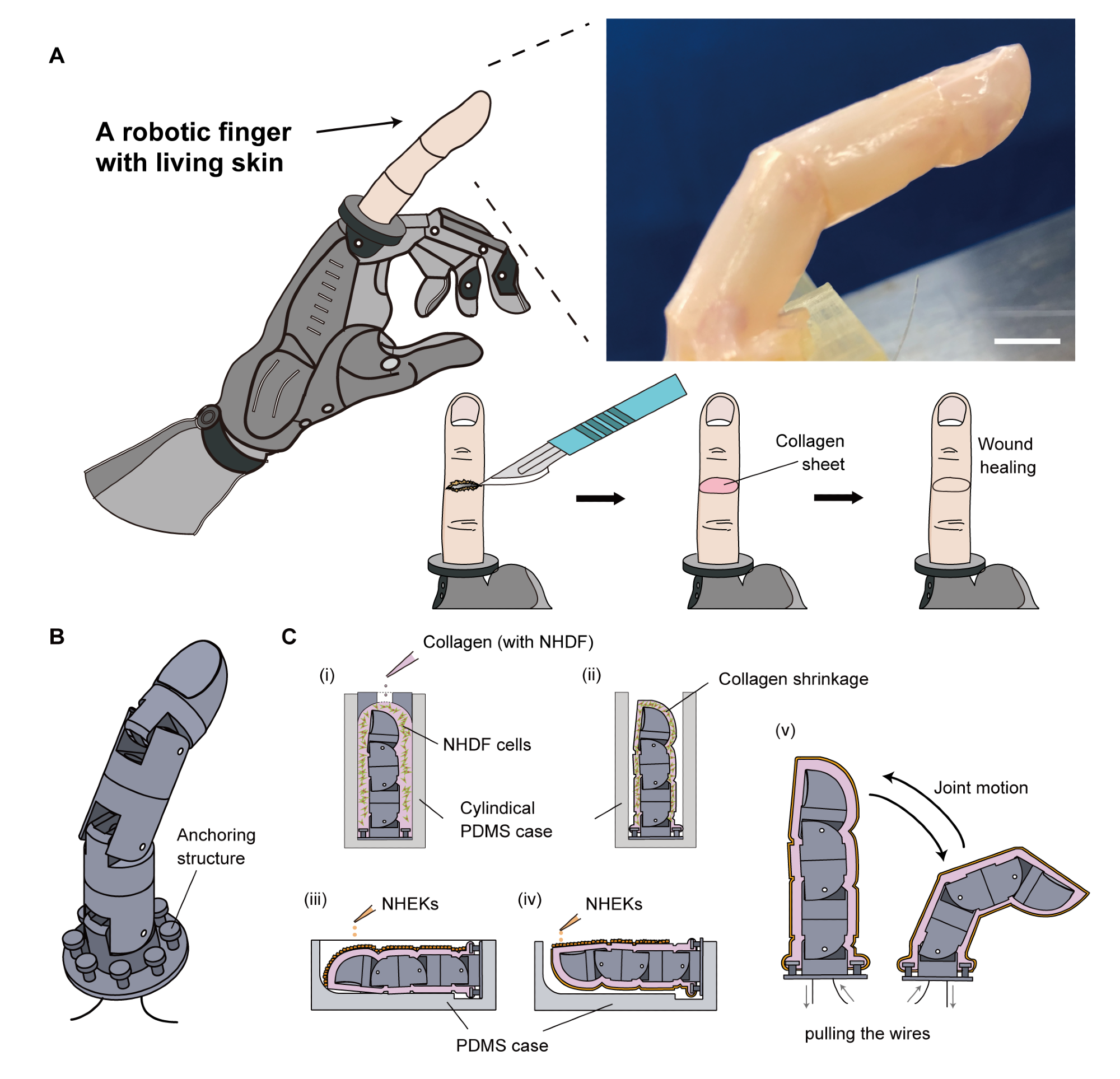The idea of self-healing skin wrapped around a robotic skeleton conjures up all kinds of sci-fi imagery, yet a group of Japanese researchers has managed to develop a controllable robotic finger covered in “living” skin which they say could bring truly human-like robots a step closer to reality.
 Image Credit: The University of Tokyo. (2022) Robot skin heals | The University of Tokyo. [online] Available at: https://www.u-tokyo.ac.jp/focus/en/press/z0508_00225.html
Image Credit: The University of Tokyo. (2022) Robot skin heals | The University of Tokyo. [online] Available at: https://www.u-tokyo.ac.jp/focus/en/press/z0508_00225.html
The team from the University of Tokyo has combined their expert knowledge in tissue culturing and robotics to make this latest innovation which could have a significant impact on how robots are developed in the near future.
Published in the journal Matter, the researchers detail the method they have developed for generating seamless coverage of 3D objects with a “living” skin equivalent. Led by Professor Shoji Takeuchi, a leader in the field of biohybrid robots, the research is a clear indicator of the intersection of robotics and bioengineering.
We have created a working robotic finger that articulates just as ours does, and is covered by a kind of artificial skin that can heal itself.
Professor Shoji Takeuchi, A Leader in the Field of Biohybrid Robots
“Our skin model is a complex three-dimensional matrix that is grown in situ on the finger itself. It is not grown separately then cut to size and adhered to the device; our method provides a more complete covering and is more strongly anchored too,” Professor Takeuchi continued.
Robotic Wound Repair
The robotic finger has living cells and supporting organic material wrapped around it for optimal strength and shaping. Due to the fact the skin is soft with self-healing abilities, it could find application in scenarios that require a gentle but strong touch.
Takeuchi works with a team of researchers that bring in different areas of expertise from across the University of Tokyo in order to explore concepts such as lab-grown meat, artificial muscles, synthetic odor receptors, etc.
The robotic finger covered in self-healing skin hopes to support medical research on skin damage, including burns and severe wounds, as well as advancing various manufacturing applications.
Takeuchi and his team were inspired by the medical treatment of deeply burned skin using grafted hydrogels.
We demonstrate wound repair of a robotic finger by culturing the wounded tissue grafted with a collagen sheet.
Professor Shoji Takeuchi, A Leader in the Field of Biohybrid Robots
Cultivating ‘Living’ Skin
For some time now, 3D-skin models have been under the lens of research and testing in cosmetics and rugs-based applications, yet this is the first time the technology has been directly applied to robotics. Comprised of a lightweight collagen matrix known as a hydrogel, the synthetic skin has several different types of living skin cells known asfibroblasts and keratinocytes
The living skin can be cultivated directly on to the robotic finger, which the researchers found to be one of the more complex aspects of this research, necessitating engineered structures that have been specifically made to which the collagen matrix can be anchored.
Our creation is not only soft like real skin but can repair itself if cut or damaged in some way. So we imagine it could be useful in industries where in situ repairability is important as are human-like qualities, such as dexterity and a light touch.
Professor Shoji Takeuchi, A Leader in the Field of Biohybrid Robots
When developing the technology further, the researchers also aim to add other kinds of cells, giving robotic devices the capability to sense as humans do.
In the future, we will develop more advanced versions by reproducing some of the organs found in skin, such as sensory cells, hair follicles and sweat glands. Also, we would like to try to coat larger structures.
Professor Shoji Takeuchi, A Leader in the Field of Biohybrid Robots
Human-like robotics could thus pave the way for new possibilities in advanced manufacturing, and while the movement of the robotic finger is purely mechanical, it could open up the door to advanced automation.
Furthermore, the self-healing skin technology could provide hope for patients that require life-changing procedures for burns or other kinds of wounds, reducing the complexity of future research.
References and Further Reading
M. Kawai, et al., Living skin on a robot, Matter (2022), [online] Available at: https://www.cell.com/matter/fulltext/S2590-2385(22)00239-9?_returnURL=https%3A%2F%2Flinkinghub.elsevier.com%2Fretrieve%2Fpii%2FS2590238522002399%3Fshowall%3Dtrue
The University of Tokyo. (2022) Robot skin heals | The University of Tokyo. [online] Available at: https://www.u-tokyo.ac.jp/focus/en/press/z0508_00225.html
Disclaimer: The views expressed here are those of the author expressed in their private capacity and do not necessarily represent the views of AZoM.com Limited T/A AZoNetwork the owner and operator of this website. This disclaimer forms part of the Terms and conditions of use of this website.